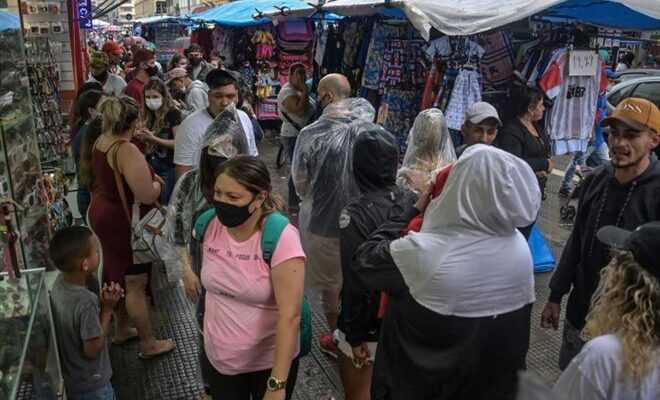Gas station attendant modifying the display of gasoline prices at a petrol station in Sao Paulo, Brazil, on December 31, 2021 (AFP / Filipe ARAUJO)
Over-indebted, Jussara Romero, 37-year-old Brazilian, does not see the light at the end of the tunnel. Galloping inflation has weighed down its purchasing power and the rise in interest rates turns the repayment of its loans into an almost impossible mission.
“We buy the products of cheaper brands at the supermarket, we no longer go to work in the car and we have eliminated leisure activities”, confides to AFP this middle-class woman who lives with her husband and her baby and manages a nursery school private in Sao Paulo.
The prices of certain products rose sharply from January to November, notably fuels (+ 50%) and poultry (+ 22.9%).
In an attempt to curb double-digit inflation (10.74% over one year in November), the Central Bank raised its key rate to 9.25% last month, the highest since July 2017.
This rate, which was at its historic low of 2% at the start of 2021, was raised seven times during the year. The rise in rates is a real headache for Jussara Romero, who juggles increasingly high expenses and delays in repaying loans.
Like many Brazilians, she resorts to installment payments with her credit card, at a prohibitive rate of 346.1% over one year. “I know it is more expensive in the end, but I have no choice,” laments this mother, who has just requested additional credit from her bank.
– Vicious circle –
“Many families spend most of their income on interest payments,” says Rachel de Sa, economist at Rico Investimentos.

On a shopping street in Sao Paulo, Brazil, December 30, 2021 (AFP / NELSON ALMEIDA)
As a result of this drop in purchasing power, household consumption, the main engine of the economy, is at half-mast.
“Inflation and rising rates have an impact above all on the consumption of durable goods, such as vehicles or household appliances,” explains Fernanda Mansano, of the financial education platform TC.
The slowdown in economic activity, largely attributable to the catastrophic Covid-19 pandemic, has another consequence: the precariousness of employment.
The unemployment rate fell to 12.1% over the August-October quarter, after peaking at 14.9% at the start of the year, but over 40% of the active population works in the informal sector, often without contract and without social protection.
The country still has nearly 13 million unemployed and the average monthly income (2,449 reais, around 380 euros) has reached the all-time low in the statistical series started in 2012.
Isaac Coelho, a resident of Embu das Artes, in the western suburbs of Sao Paulo, is one of these precarious workers. He earns his living as a bicycle delivery man.
“It allows me to cover certain expenses, such as the gas cylinder that I paid 60 reais (around 9 euros) in 2020 and which costs 100 reais (15 euros) now.
– Real estate loans inaccessible –
Bruno, a 35-year-old resident of Sao Paulo who did not wish to reveal his last name, currently lives with his father while he waits to find an affordable apartment.

On a shopping street in Sao Paulo, Brazil, December 30, 2021 (AFP / NELSON ALMEIDA)
“My bank granted me a loan at 8.9%, but this rate is only valid for three months. If I cannot find an apartment before, the rate will no longer be guaranteed,” says Bruno.
The banks have not yet fully passed on the hike in the key rate, but “mortgage loans have gone from 6.3% per year at the start of 2021 to around 10% today”, explains Rafael Scoledario, a specialist in the real estate market.
And further hikes are expected, with economists forecasting a key rate of 11.5% during 2022, although inflation could start to decline due to the slowing economy.
In this year, which will be marked by the presidential election in October, economic forecasts are hardly optimistic.
The specialists consulted during the latest weekly Focus survey of the Central Bank expect GDP growth of only 0.42% in 2022, while they predicted an increase of 2.5% at the start of 2021.
© 2022 AFP
Did you like this article ? Share it with your friends with the buttons below.




